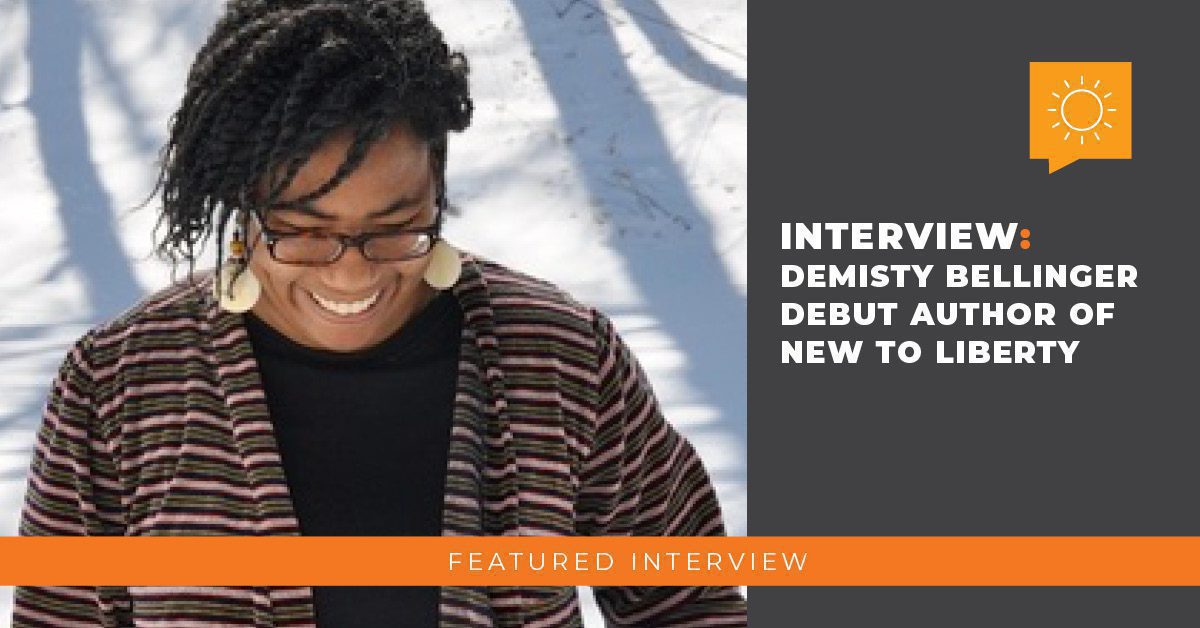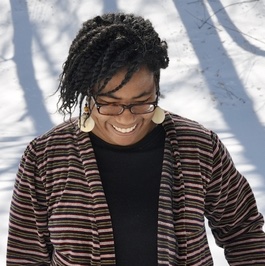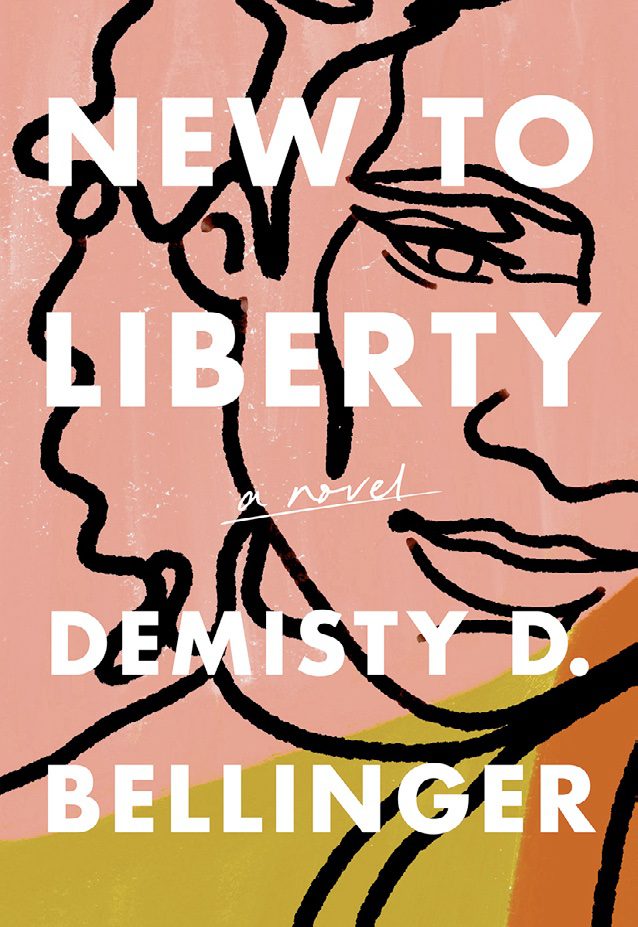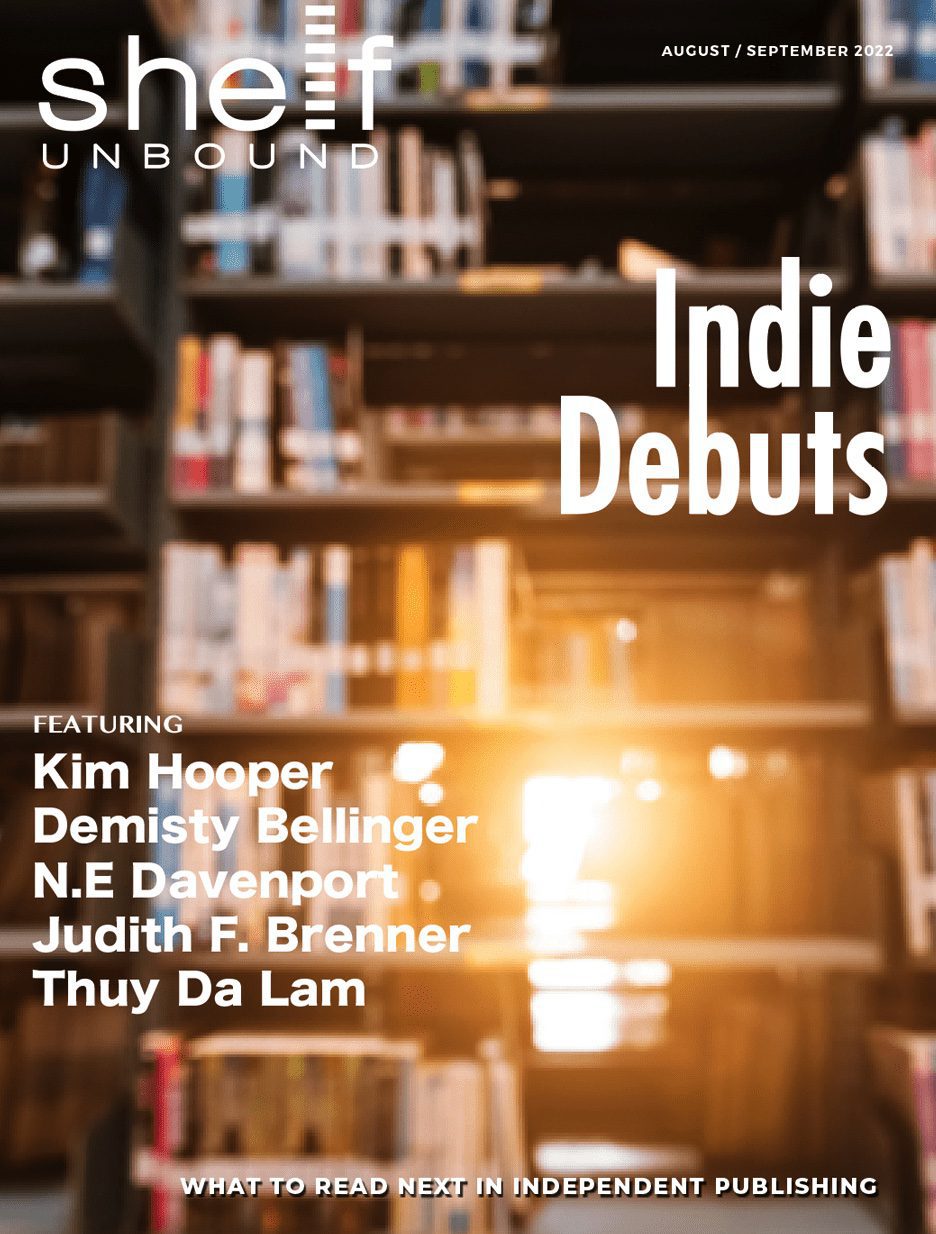By Michele Mathews

DeMisty Bellinger released her debut novel, New to Liberty, in April. She has written poems and short stories among other things. I had the chance to interview her and learn more about not only her but her new book as well.
Tell us a bit about yourself.
DB: I teach creative writing at a small, New England regional state university. I’m originally from the Midwest, and no matter how many years I spend here, I can’t quite find my footing. I heard someone say that you are an outsider unless your family came over on the Mayflower and that kind of rings true. Don’t get me wrong. I have found friends here! I think.
Still, every day, I miss my hometown of Milwaukee and the Midwest in general. Though the hokeyness there is ofttimes insincere, I still long for the simple kindnesses passed off by strangers.
But then, I’m not talking about myself really. I grew up in public schools and was fortunate enough to attend the arts schools. I studied English at the University of Wisconsin-Platteville, my first extended stint in rural life. I fell in love there and brought my partner with me while I studied creative writing in Southampton, New York, for an MFA, then to Lincoln, Nebraska for my PhD in English.
I have twin daughters who I am absolutely in love with. My love for my little family is uncontainable.
You’ve done all kinds of writing. Tell us about your writing journey.
DB: I started writing in preschool, and I did not stop. In grade school, I was encouraged to write by my teachers, and in high school, I spent three years in remedial English. It was horrid, but not. I mean, I got flying colors in the class (I think. My memory is cloudy.), but I flunked the competency exam every year. Demoralizing for an aspiring writer!
To this day, I have such a problem with testing that I do not give them out in my classes. I used to, but I found that I don’t like getting physically sick when preparing students or proctoring exams.
Publishing my work was a long time coming. A little after my MFA, I won a local poetry contest through the main branch of the Milwaukee Public Library. My poem was published in a limited broadside. I published a few articles after college and during grad school in small newspapers and on blogs. I didn’t publish my first short story until I was well into my graduate program at the University of Nebraska-Lincoln, and I didn’t publish my first book of poems until I was employed as a professor. I think I was over forty then. Who keeps counting after twenty-one?
Regarding the genres, I write in so many because the writers I enjoyed as a kid—Langston Hughes, Edith Wharton, Alice Walker, Toni Morrison, and even Stephen King—wrote in many different genres. Alice Walker and Margaret Atwood, I’d argue, are equally good at fiction and poetry. Langston Hughes is probably most famous for his poems, but he’s an excellent essayist, short story writer, and playwright. I thought writing in all genres was required of all writers.
Today, I’m still learning how to write different types of documents. Recently, I started writing reviews, which I enjoy a lot more than I thought I would. Once I get comfortable with reviews, I don’t know what I’d do next. Longform journalism seems like fun!
What inspired you to write new to liberty?
DB: Sunflowers, big skies, the Dust Bowl, and jackrabbits. When waiting in line at a grocery store, a woman told me about visiting a sunflower field. She said that she felt like being in a walled-in topiary. I loved that imagery, but I can’t remember why she told me about it.
The first thing I noticed when I moved to the Great Plains was how much of the sky I could see. No trees or tall buildings blocked my view of that shocking blue sky. I understood then the term big skies.
While reading books for my comprehensive exams, which was on working class literature, I read a lot about the Dust Bowl, and my fascination with that phenomenon, made through development and mistreatment of prairie lands, and the people who survived it. I also read about the jackrabbit roundups in Kansas, where hundreds of thousands of rabbits descended on the prairies for food like locusts. Farmers and ranchers rounded up the raiding rodents.
Imagery, I suppose. I’m a slut for good imagery, and the Great Plains is rife with it. The imagery of the historical Great Plains partly served as my inspiration.
Why did you choose to write your novel in three different points of views?
DB: I wish I had a brilliant answer here, but I don’t. The structure of the book was a matter of practicality. I wrote Sissily’s story first, which was a short story that got out of hand. Then I added the other two stories. The first iteration of the book was one perspective, but I decided in a later draft to mix the women up chapter by chapter, going forward and backward in time, each with her own voice. New to Liberty is the last version of that structure, and I wanted it in three parts because I wanted each woman to have our undivided attention for her entire tale.
New to liberty spans three different decades. What was your reasoning for doing this?
DB: New to Liberty answers a couple of questions for me: One, who did the people who lived through the worst of the Dust Bowl, those who were able to stay and weather the storms, grow up to be? And two, why would a young person choose to be in a relationship with a much older partner?
I tried to answer these questions by looking at those lives during the Great Depression, then a few years later after WWII to see how these characters fared, then finally, during the 60s. I wanted each storyline to be during eras of great change, but I also wanted the characters to be on the fringes. These are regular Americans in the midst of flux.
What kind of research did you do while you were writing your novel?
DB: I read a lot of contemporaneous novels from each period, but I also read histories such as Timothy Egan’s The Worst Hard Time. Documentaries offered archival photos and videos as well as first-person accounts of living through these eras, so I ate those up, too. For certain specifics in furniture or cars, I called my parents, who are antique dealers. My dad especially knows a lot about cars, so I asked him about the vehicles the characters drove. My husband grew up in rural Wisconsin, so he knows about farm equipment, so I had a lot of questions for him when writing Greta’s section.
Mostly, living and traveling in the Great Plains informed the landscape and inspired the characters in the book.
When in Nebraska for grad school, my husband and I often went on excursions to neighboring states. The seemingly endless fields along I-80, the impromptu conversations with people who had long roots in the area, the skies that both opened up the world and closed it in through their vastness are all rich source materials.
What message do you hope readers take away after reading new to liberty?
DB: I would like to think that I have two messages: that you can emerge from violence without letting it define you, and that there is always hope.
What’s next for your writing career? Do you have plans to write more novels?
DB: I am writing a novel now that follows one character who has to decide to stay in the land of the living or go to the other side. It’s a modern-day It’s a Wonderful Life/A Christmas Carol, sans Christmas and including racism and magic. Really, it makes sense!
I also have this ever-growing collection of short stories with no connectivity, so it will probably remain in various magazines and on my hard drive. Of course, I’m still writing poetry. I’m years in on an ekphrasis project. Again, I’m writing reviews! So there’s that.

About the Author
DeMisty Bellinger
Besides writing, DeMisty D. Bellinger is a poetry editor at Malarkey Books, an alumni reader at Prairie Schooner, and a professor at Fitchburg State University. She has a BA in English from University of Wisconsin-Platteville, an MFA from Southampton College, and a PhD from the University of Nebraska. She is an alum of Bread Loaf and Marge Piercy’s Intensive Writing Workshop.
Also, she attended the Vermont Studio Center on a fellowship. DeMisty lives in Massachusetts with her husband and twin daughters.

New to Liberty
Three women, decades apart from each other, fight for love and agency in a rural Kansas community seemingly frozen in time:
1966: Sissily is driving cross-country with a much older man called Ezzy. On their way to California to begin a life together, he insists on stopping at his family ranch outside Liberty, Kansas visit his mother, Mrs. Svoboda. This family reunion is a painful reminder for Sissily of the rumors about the scandal that led to her running away from home, but while Mrs. Svoboda is a domineering figure, Sissily sees a woman who harbors secrets of her own.
1947: Nella’s family relocates to Liberty from Milwaukee, and during the summer before her senior year, begins an interracial relationship with a white man called Lucky.
They can only meet in secret, or as Lucky is in a wheelchair sometimes Nella pretends to be his nurse. When three white men stumble upon “Nurse Nella” one catastrophic afternoon, the violence of a racist society forces Nella to face the harsh reality of her love affair.
1933: Greta finds love with a woman from the neighboring farm during the height of the Dust Bowl and brutal jackrabbit roundups. Surrounded by violence and starvation, their clandestine encounters are unsustainable, and yet the implications of their relationship will find a way to endure for generations.
A novel told in three parts, New to Liberty showcases the growth and strength of three unforgettable women as they evolve in a society that refuses to. In lustrous prose, DeMisty Bellinger brings the quiet but treacherous landscape to life, offering a vivid snapshot of mid-century America and keeping readers guessing until the end as to how these three women are connected.

[cm_page_title title=”Continue Reading” subtitle=” Shelf Unbound”]
Article originally Published in the August / September 2022 Issue: Indie Debuts.
